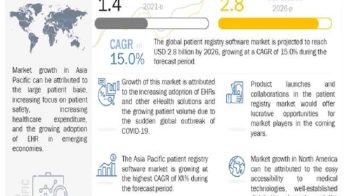Expected Surge in Revenue:
The global air quality monitoring system market is valued at USD 4.4 billion in 2021 and is expected to reach USD 5.9 billion by 2026, at a CAGR of 6.5% during the forecast period.
Major Growth Boosting Factors:
The growth of this market is majorly driven by factors such as rising levels of air pollution, supportive government regulations for effective air pollution monitoring and control, and ongoing initiatives toward the development of environment-friendly industries.
Adding to this, increasing public-private funding for effective air pollution monitoring, and the increasing public awareness related to the environmental and healthcare implications of air pollution also supports the growth of this market.
Restraint: High product cost
The high installation cost and high maintenance cost of conventional air monitoring system hinders the growth of the market. For instance, the installation of reference air quality monitoring stations is expensive and costs anywhere between USD 100,000–200,000 for a single station. In India, the cost of a single AQM station is estimated to be between USD 0.21–0.35 million (excluding the costs of yearly maintenance). The maintenance cost of pollution-monitoring stations is also high (up to 10% of the installation cost for overall maintenance during a 10-year period).
Download PDF Brochure@
https://www.marketsandmarkets.com/pdfdownloadNew.asp?id=183784537
The indoor monitors segment accounted for the largest share of the global air quality monitoring systems market, by product, in 2020
On the basis of product, the air quality monitoring systems market is segmented into indoor monitors, outdoor monitors, and wearable monitors. Indoor monitors market is further segmented into fixed indoor monitors and portable indoor monitors. The outdoor monitors market is also segmented into portable outdoor moniotrs, fixed outdoor monitors, dust & particulate matter monitors and AQM stations. Indoor monitors commanded the largest share of the global AQM products market in 2020.
Opportunity: Continuous R&D and technological advancements
The continuous research and development, and commercialization of advanced AQM systems (such as miniaturized devices, nanotechnology-based systems, infrared spectroscopy, and remote-sensing instruments) are expected to offer significant growth opportunities for prominent as well as emerging players in the AQM industry. Consequently, various industrial players and research organizations are increasingly focusing on developing and commercializing advanced AQM products. For instance, nanotechnology based AQM products offer several procedural benefits, such as real-time monitoring capabilities, device miniaturization, increased analytical efficacy, and affordable manufacturing.
The chemical pollutant segment, by pollutant, accounted for the largest share of the global air quality monitoring systems market in 2020
On the basis of types of pollutant monitored by air quality monitoring devices, this market is segmented into chemical pollutant, physical pollutants, and biological pollutants. The chemical pollutants segment is further segmented into nitrogen oxides (NOx), sulfur oxides (SOX), carbon oxides (COX), volatile organic compounds (VOCs), and other chemical pollutants. The chemical pollutants segment commanded the largest share of the global air quality monitoring systems market, by pollutant, in 2020.
Challenge: Slow implementation of air pollution control reforms
One of the major challenges associated with the air quality monitoring systems market is the slow implementation of air pollution regulations. Several emerging countries (such as China and India) have been reported to be slow in implementing stringent environmental pollution monitoring norms during the past decade. For example, in April 2021, government of India postponed the deadline for thermal powerplants to install Flue Gas Desulphurization units to cut the emissions of sulfur dioxide, and allowed utilities that miss the new target to continue operating after paying a penalty, according to a government notice.
The Asia Pacific market is expected to grow at the highest CAGR during the forecast period
On the basis of region, the air quality monitoring systems market is segmented into North America, Europe, Asia Pacific, Latin America, and the Middle East & Africa. The asia-pacific market is expected to register the highest growth in the forecast period. Countries in this market are witnessing growth in their GDPs and a significant rise in disposable income among the middle-class population. This has led to increased expenditure by various regional government on air quality monitoring activities, modernization of industrial and public infrastructures, and rising penetration of cutting-edge environmental monitoring technologies. All of these factors contribute to the high CAGR of the region.
Request Sample Pages@
https://www.marketsandmarkets.com/requestsampleNew.asp?id=183784537
Key Market Players
The dominant players in the global air quality monitoring systems market are Thermo Fisher Scientific (US), Emerson Electric (US), General Electric (US), Siemens AG (Germany), Teledyne Technologies (US), PerkinElmer, Inc. (US), Agilent Technologies, Inc. (US), Spectris plc (UK), 3M Company (US), Honeywell International Inc (US), HORIBA, Ltd. (Japan), Merck KGaA (Germany), TSI Incorporated (US), Tisch Environmental (US), and Testo (Germany), among others.

